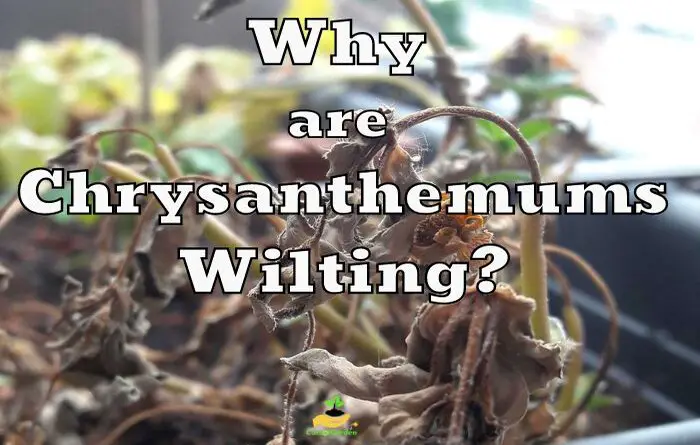Why are Chrysanthemums Wilting? (Easy Answer Here)
Have you bought a chrysanthemum and within a few days they start to dry out and wither. In this article you will find out why are chrysanthemums wilting?
The obvious reasons why chrysanthemums are wilting is the dryness of the soil due to lack of water. It can also be caused by waterlogged due to poor soil drainage or overwatering, too much light (especially if wilting occurs at noon), too much heat, or diseases like Fusarium Wilt.
| Causes Why Chrysanthemums are Wilting? |
|---|
| 1. Lack of water |
| 2. Overwatering |
| 3. Temperature Imbalance |
| 4. Fusarium wilt |
1. Lack of water
The most common reason why chrysanthemums or commonly called mums are wilting is that they are not getting enough water. It is enough to know that plants lose water through their leaves and capture it through their roots.
When the soil dries up and it doesn’t have to be completely dry, the plant has more and more difficulties obtaining water from it. It enters a situation of hydric stress and the symptoms begin to be noticed: wilted leaves.
Potted chrysanthemums prefer to be kept evenly moist. They will dry out quickly in direct sunlight and then shed their buds and wilt.
However, once chrysanthemums have dried out, they hardly recover from the shock.
How often you have to water depends of course, on the location, the temperatures and the size of the pot. If a chrysanthemum is in the sun, you have to water it every day, even in the autumn.
Chrysanthemums need to be watered at least every three days if they are going to keep healthy and fresh. This can be done by placing a pot of water in the center of your flower arrangement, and then filling it with water.
You can also use a spray bottle or softener sheet to help keep your flowers hydrated. If you notice that your mums are wilting, it may be because they are getting too much water or not enough water at all.
Also, be careful not to overwater the plant. The top layer of soil should be dry before the next watering.
Do not water from above because moisture can remain on the mums leaves and flowers and powdery mildew can quickly develop.
How to Treat Lack of water
As for watering, the chrysanthemum needs frequent watering so that the soil is always moist. Such plants should be transplanted as soon as possible to prevent their wilting.
To do this, hold the edge of the pot in a bucket under water until no more bubbles rise up; once you’ve checked them. Give them some time to recover by covering them with fresh soil before planting out again.
If the plant is grown in pots, the chrysanthemum can be irrigated by immersing the container in water for a few minutes, then allowing the water to drain very well. During the warm months it is also possible to vaporize the plant with rainwater, especially if grown indoors.
Outside and in the open ground, watering must be abundant during the summer months and must be done early in the morning, without excessively wetting the leaves and the base of the mums soil.
2. Overwatering
The second reason why chrysanthemums are wilting is if they’re being overwatered or watered too frequently. Overwatering can cause roots to rot, which will lead to wilting flowers.
The soil becomes waterlogged, the water fills all the pores in the earth that were filled with air. Then root suffocation and rot caused by microorganisms that develop in anaerobic conditions (in the absence of oxygen) appear.
Under these conditions, the plants turn yellow, do not show any growth and end up withering. When extracting them from the ground, it can be observed how the roots are blackened and partially decomposed, completely losing their important function.
It’s best to water your plants once every two weeks rather than every day, since they’ll get enough water in between watering sessions. If you notice your plant has started to wilt, this could be a sign that it’s time for another watering session!
Indoor plants require just as much water as outdoor plants do, but with the difference being that indoor plants do not get the same amount of rainwater as their outdoor counterparts do.
It is important for you to keep an eye on how much water your plant needs in order to prevent too much moisture from building up in the soil which can lead to root rot or even death for some plants!
Waterlogging usually occurs in soils with poor drainage, that is, soils that do not allow water to escape. This generally occurs in clay soils (soil with a very fine texture, almost like flour) or in low-lying areas, where the water has no natural outlet.
How to treat Overwatering
To avoid waterlogging, water drainage must be guaranteed, avoiding planting in depressed areas of the land (if it is flat, ridges can be raised and planted on top of these)
In pots, it frequently occurs when care is not taken to make drainage holes at their base or when they are filled with an inadequate substrate.
If you are growing chrysanthemums in pots outside, make sure they have plenty of drainage holes in their bottom halves and make sure they get enough sunlight throughout the day.
3. Temperature Imbalance
Temperature fluctuation is the third factor that causes chrysanthemums to wilt and dry out. When temperatures rise too high, some plants may not be able to keep up with the heat and then they’ll start wilting at their base or tips where they touch soil or container walls (like in clay pots).
The temperature plays a major role in causing chrysanthemum wilting. If the temperature rises above 70°F (21°C), most chrysanthemums will start to wilt within 24 hours.
The majority of chrysanthemums in pots are not hardy. Some varieties are even suitable as houseplants, but only a few for planting out in the garden. Therefore, choose a place that is as sheltered as possible for late bloomers.
Conversely, if the temperature falls below 50°F (10°C), most chrysanthemums will not wilt at all even though they have reached their optimum growth stage at this point in time.
They do not tolerate heat, so if you have it indoors, it must be in a well-ventilated and cool room. Outdoors, they are affected by cold and frost when winter arrives.
Temperature too high (Heat)
Chrysanthemums start to wilt when exposed to high temperatures, especially in sunny weather. If a chrysanthemum flower is exposed to warm temperatures for too long, it will begin to dry out and eventually shrivel.
This is caused by the flower’s inability to produce sufficient water, which can be attributed to poor air circulation or poor drainage. In addition, if your chrysanthemums are not watered properly, they may wilt as well.
Heat from the sun or air conditioning can also cause mums to wilt because they don’t get enough water during these times of year.
It’s important to check on your plants every day if you live in a hot area!
Chrysanthemums need mild temperatures, between 55-60 °F (13 and 20º C).They do not tolerate heat, so if you have it indoors, it must be in a well-ventilated and cool room.
Outdoors, they are affected by cold and frost when winter arrives.
Potted mums must be placed on the windowsills on the west or east side. If it is placed in the south side, the chrysanthemums will wither from excess heat and from the north, it will not bloom well.
Temperature too low (Frost)
Plants that are exposed to extreme temperatures such as frost will die even if they have adequate amounts of sunlight exposure and proper watering schedules throughout the year. Frost causes irreversible damage to mums that cannot be repaired with proper care afterwards.
It is therefore normal for the chrysanthemums to react in some way to this environmental shock, in your case by causing some flowers to wilt and eventually to dry out and fall off.
It is very common for temperatures below 32°F (0°C) to cause frostbite in plants, followed by the death of affected tissues and even the entire plant.
The juiciest tissues are the most susceptible to freezing, and also the plants that originate from areas with always warm climates.
How to treat Temperature Imbalance
To avoid frost damage, they must be planted after the risk of frost has passed or protected with special blankets, greenhouses, tunnels, etc.
It is a very common practice to plant or place mums next to a wall facing the sun , so that the wall heats up during the day and at night acts as a radiator that maintains the highest temperature in its vicinity.
For its good growth, the ideal temperature range is considered to be:
- in winter: 37-46 °F ( 3 to 8 °С);
- summer: 59-64 °F (15 to 20 °С);
- in the autumn-spring period: 55-60 °F (13 to18 °С).
4. Fusarium wilt
This is one of the fungi that can most affect chrysanthemums. It causes the leaves to turn yellow and wilt, sometimes causing the death of the plant.
This fungus remains in the soil and contaminates the roots of the plant and sometimes also the sap. It is caused by excess moisture in the substrate.
If the chrysanthemum gets sick with it, then mainly during the period of buds and flowering. At the same time, the leaves fade from the bottom up, without losing their green color. As a result, the base of the stem turns black and then rots.
The manifestation of the disease increases with hot temperatures, heavy rainfall and an excess of nitrogen-containing fertilizers.
You can also recognize an infestation through lightening or yellowing of the leaves, curling of leaves, rotting of the roots, a white-pink mold, wilting of the plant. White and pink fungus networks first appear on the roots, then spread up along the stem to the leaves.
The Fusarium fungus clogs the mums root channels so that it can no longer absorb water and withers. In the case of an infestation, permanent spores form, which get into the soil when the plant withers.
They then remain dormant in the soil for several years before infesting a new host plant. Once a new host has been found, the reproduction cycle begins again.
How to treat Fusarium Wilt
Removal of affected plants with a clod of earth, the use of healthy planting material, in particular cuttings. In industrial cultivation, spraying plants, soils with a 0.2% solution of the systemic fungicide.
Only use healthy and undamaged plants, bulbs or tubers. It is also an advantage if you prefer resistant varieties to others. If you do a sowing, you can do a seed dressing with chamomile tea.
Speaking of fungi and mold, do you know the reasons why are Mushrooms in Peace Lily Soil?
How to Revive Wilted Chrysanthemums
There are several steps that you can take to revive your wilted Chrysanthemums:
- Step 1: Wash your chrysanthemums thoroughly. You can use a soft cloth with warm water or a sprayer to make them look new again.
- Step 2: Remove any dead leaves. This is important because it can prevent the blossoms from opening and making more buds to bloom.
- Step 3: Cut off all the faded branches by a third of their length, starting from the tip, with a sharp scissor. If you notice that a part of the stem has died, cut it off completely so that you will have a clean stem for your plant to grow.
- Step 4: Remove the Chrysanthemums from the vase and lay them on a flat surface, like a table or countertop, for an hour or so.
- Step 5: Rinse the Chrysanthemums with room temperature water to remove any excess dust from the soil and water them again with fresh water until they are fully hydrated.
- Step 6: Place the Chrysanthemums back in their original vase and cover them with fresh soil, making sure that it is moist but not dripping wet.
- Step 7: Leave them alone for at least 24 hours before viewing them again, as this will allow time for any remaining moisture to be absorbed into the soil of your Chrysanthemums’ roots without evaporating away completely.
- Step 8: Water regularly until your plant begins to show signs of new growth and then continue watering every day until they are fully grown.
How to maintain Chrysanthemums
| Location | Sunny |
| Light | Indoors, it should be placed in a very bright place. Outdoors, it should be located in partial shade. |
| Watering | 2 or 3 times/week in summer In pot make sure they do not become waterlogged. |
| Fertilizer | Special fertilizer for flowering plants every spring. In a pot provide it with liquid fertilizer regularly from April to September. |
| Cut | The months of May, June and July are good for cutting back the flower several times. 1m maximum |
| Diseases | Powdery mildew, fusarium wilt, rust and aphids |
| Temperature | Between 54 and 62°F (12-17 °С). |
| Soil | With high level of fertility, with a sandy consistency. pH between 5.5 and 6.5. |
Pruning the chrysanthemum allows, not only to remove the withered and rotten branches , but also to favor the hardening and strength of the stem. The chrysanthemum should be pruned by cutting the withered branches about 10 cm from the ground.
Before winter arrives, clean the base of the mums from the remaining leaves. In this way you will avoid the formation of rot of the collar. Mulch with a mixture of leaves and peat to cover the stem during the winter.
Conclusion
As you’ve seen in this article, there are various reasons why chrysanthemums are wilting and not all of them depend on you, thankfully, but understanding the cause can help you take measures for the next time you encounter this problem on your chrysanthemums.
With optimization of care, preventive treatments and timely treatment of diseases, wilting can be avoided. As a result, you will get beautiful, brightly flowering chrysanthemums that will delight you with its decorative effect for several years.
Frequently Asked Questions
Chrysanthemums are perennials, but not all varieties are hardy. Especially chrysanthemums from supermarkets, and garden centers wither at temperatures below -5°C and therefore often end up on the compost after flowering.
Water your chrysanthemum regularly throughout the summer and in case of drought, only when the soil is dry.
The only recommendation is not to wet the foliage to avoid the appearance of diseases such as powdery mildew and rust.
The chrysanthemum is repotted in the fall, in special, well-drained chrysanthemum soil.
Unfortunately, many of the beautiful (house) plants are poisonous. This includes the chrysanthemum. It is particularly dangerous for cats and dogs. Symptoms of poisoning such as irritation of the mucous membranes or drowsiness (in the worst case, kidney and liver failure) can occur when the plant is eaten.




